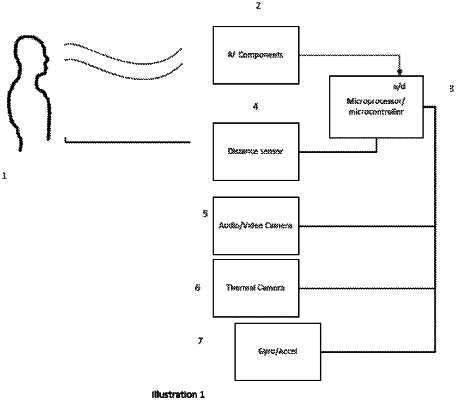| CPC A61B 5/02055 (2013.01) [A61B 5/05 (2013.01); A61B 5/7228 (2013.01); A61B 5/0059 (2013.01); A61B 5/024 (2013.01); A61B 5/0816 (2013.01); A61B 2562/0204 (2013.01); A61B 2562/0219 (2013.01); A61B 2562/0257 (2013.01)] | 20 Claims |

|
1. A system for at-a-distance non-contact monitoring of one or more vital signs of a subject, the system comprising:
at least one detection device that detects one or more signals from a living body without any physical contact to said living body, wherein said detection device comprises at least one RF transmitter and at least one RF receiver, and wherein said one or more signals is an RF signal transmitted from said RF transmitter and received by said RF receiver from the reflection of the transmitted RF signal from said living body;
at least one computing device for receiving said one or more signals from said at least one detection device, and analyzing said one or more signals to estimate one or more vital signs of a said living body, wherein said one or more vital signs comprise heart rate and respiratory rate; and
at least one monitoring device allowing one or more user to monitor said one or more vital signs computed by said at least one computing device;
wherein the at least one computing device contains a non-transitory computer readable medium containing instructions, that when executed perform the method of:
transmitting the RF signal from the at least one RF transmitter;
receiving the RF signal reflected from said living body by the at least one RF receiver;
analyzing the RF signal received by the one or more RF receiver to detect one or more vital sign of said living body;
determining a signal strength and quality score of the one or more vital sign identified in the RF signal, wherein determining the signal strength and quality score further comprises:
a) evaluating the one or more RF signal based on analog signals received from the RF signal transmitted from said RF transmitter and reflected back from said living body by processing the RF signal received through a digital to analog converter (DAC) to provide the heart rate of said living body, evaluating the signal strength and generating a scale of signal strength using a time-scale to determine the heart rate, wherein the more inconsistent or fluctuating of the heart rate, the lower the quality score, and wherein the more consistent or non-fluctuation of the heart rate, the higher the quality score; and
b) evaluating the one or more RF signal based on analog signals received from the RF signal transmitted from said RF transmitter and reflected back from said living body by processing the one or more RF signal received through the DAC to provide the respiratory rate of said living body, evaluating the signal strength and generating a scale of signal strength using a time-scale to determine the respiratory rate, wherein the more inconsistent or fluctuating of the respiratory rate, the lower the quality score, and wherein the more consistent or non-fluctuation of the respiratory rate, the higher the quality score; and
communicating a filtered one or more vital signs of said living body being monitored to said at least one monitoring device.
|